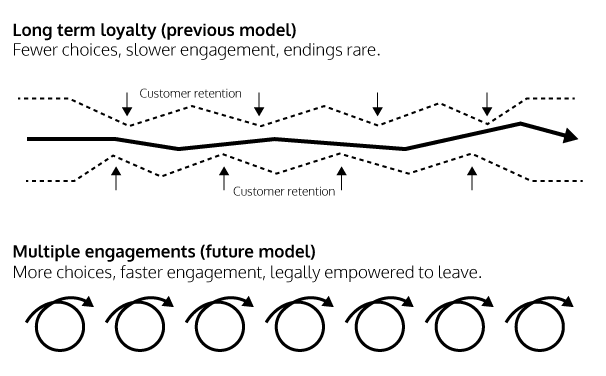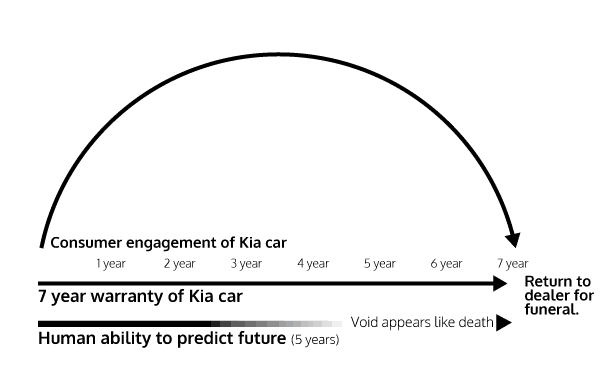
Examples: Good and bad endings.
Multiple engagements
Life long loyalty is over. Re-engagement with consumers is going to become the norm, rather than the exception.
Business logic argues that it cost five times more to acquire a new customer than to retain a current one. But this binary statement overlooks the potential or, indeed, the reality of endings. Future services and digital products are promising to be far more transitory than in the past. Consumers are going to move more quickly between services, empowered by legislation such as Open Banking and Data Portability in GDPR.
They will turn one service off as they switch another on, approving and removing consent as they come and go. Returning to services and providers they used previously will be common. So making the ending of a service a good one is vital.
Personal, unique experiences only at the end.
The consumer’s experience is biased. As businesses and society, we favour the on-boarding of a new product or service over the responsibility of off-boarding. Engagement through advertising, and marketing inspires commitment from the consumer at the beginning of the consumer lifecycle (On-boarding).
Off-boarding is overlooked. Left to governments, local council, health and welfare, and international bodies to deal with. The language, status and position of these are in counterpoint to other messages and authorities inside the consumer lifecycle. It is no wonder the consumer has little to link their action at purchase to their responsibility thereafter.
Yet, emotional off-boarding can motivate some interesting feelings in the consumer, inspiring them to be truly reflective about the products and services in the context of individual consumption, directly linked to a personal experience through witnessed evidence that creates responsibility.
In contrast, the on-boarding experience presents an aspirational, dreamlike experience to the consumer, luring them in to the consumer relationship, which can only be predictive as it is before the product or service has been experienced.
Worryingly though, the types of promises the consumer experiences at on-boarding are now being adopted to present sustainable consumption and environmental credentials. Yet these methods can only act as a proxy of real action in the consumer as they are achieved only via a purchase from the provider.
Planned Endings
Acknowledging the end can help planning the off-boarding experience. Setting a date and time of the end helps people feel reassured. Some of the worlds most successful businesses have put planned endings at the core of their business.
Snapchat
Grew between $58m in 2015 too $824m in 2017.
‘Enjoy fast and fun mobile conversation! Snap a photo or a video, add a caption, and send it to a friend. They’ll view it, laugh, and then the Snap disappears from the screen.’
187 million daily active users
3.5 billion average number of snaps a day
35% of Snapchat users use it because their content disappears
Kia Cars
Kia introduced their Cee’d car in 2007 with a 7 year warranty. An industry leading initiative that shattered the previous norm of 3 years.
Humans find it hard to predict beyond 5 years ( a reason you get those cliche questions at job interviews, and from financial advisors). So 7 years seems like a void. Similar to death.
A date between Kia and the customer, 7 years in the future provides a healthy platform for discussion and feedback when the consumer wants to buy a new car and the old one needs recovering, recycling, or re-selling.
Many manufactures don’t have an open communication channel beyond the 3 years - the length of many warranties. This limits their capability at recovering a product and dismantling it for recycling. It also avoids the fantastic opportunity that Kia has embedded into the life of their products - in essence a funeral that brings the opportunity of re-birth (a potential new car sale).
The 7 year warranty is a big attraction to new customers. According to COO of Kia Australia, Damien Meredith “The major reason people buy our product now is the warranty. Price has slipped to third,”
Since introducing the 7 year warranty, Kia market share has more than doubled, from 1.2 percent in 2007 to 3.2 percent in 2014.



